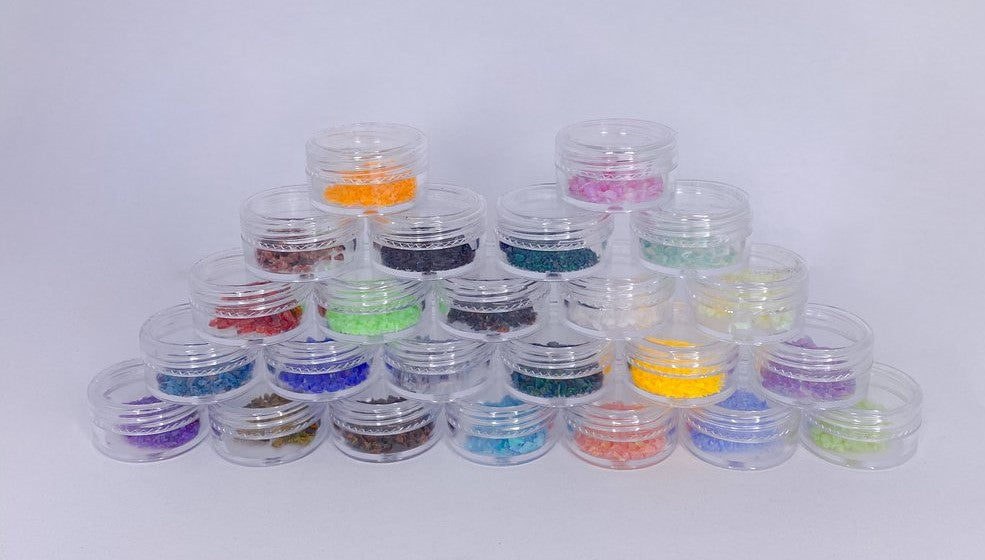To learn about how synthetic opal is made, a brief history of opal is recommended. Opal is a gemstone is an amorphous (a fancy way of saying without shape) form of silica called silicon dioxide (SiO2 for those of you who paid attention in chemistry). Silica is just a combination of silicon and oxygen. While opal is a gemstone made from silica, it's not a crystal. The crystalline form of silica is what you know as quartz.
Opal has a chemical makeup that is very similar to quartz. The key difference is that opal contains trace amounts of water (making it SiO2 + H2O for the chemistry buffs). Though opal isn't actually a crystal it doesn't mean that its laid out chaotically. There is an internal order presence that is what causes light diffraction. Light diffraction is the most important characteristic that differentiates Opal from all the other cool gemstones because diffraction is what is responsible for all of Opals signature colors.
Diffraction is actually so important that the word "opal" is commonly believed to be derived from the Greek word opallios which means to see a change of color. While opal has existed for millennia, it first became widely available on the market in the 1890's from a mine in South Australia. Opal has been considered a precious gemstone by Roman Mark Antony, Pliny, and the ancient Greek Theophrastus. Even Shakespeare dubbed opal the "Queen of Gems". Over 95% of worldwide natural opal is supplied by Australian opal mines - and it certainly is expensive (which explains why its often called Precious Opal).
Common Opal versus Precious Opal
The major difference between common opal and precious opal is that common opal doesn't have the "play-of-color" (the thing that makes opal show a spectrum of colors). This makes common opal a very cheap gem that is not often used in commercial or designer jewelry. The difference between common and precious opal is important because this is what determines if an opal is a virtually worthless gemstone or an actual precious stone.
Common opal (sometimes called Potch, which sounds even worse than common opal) is still a natural opal that is often found in areas with sedimentary rocks and arid climate as well as areas with volcanic activity. Common opal is still available in a variety of beautiful colors and is fairly inexpensive. The reason its cheaper is because it can't diffract light in the same way precious opal can. Because of this, it can be sold in any size, form, or cut, and the physical and chemical properties are the exact same.
Precious opal is primarily defined by the presence of play-of-color. This makes it more expensive because preserving the play-of-color requires a lot of care, skill, and study. Before they can cut it, they need to examine the opal and find the location, orientation, and pattern of the play-of-color. The goal is to maximize the presence of the feature which is what determines the precious quality opal. If they cut the stone incorrectly, it loses its ability to diffract light and becomes common opal.
Synthetic Opal
Due to the costly character of natural opal, scientists set out to create synthetic opal– a cheaper alternative to natural opal. In 1974, Pierre Gilson invented the first form of synthetic opal in a lab. Since then, synthetic opal has become a reality within the jewelry world. With advancing technologies, even the best gemologists have trouble deciphering between natural and synthetic opal. Synthetic opals are known for their wide variety of dazzling colors, patterns, and interaction with light.
Synthetic opal is often misused and there are actually multiple grades of man-made opals. The two most common are synthetic and imitation opal.
Imitation opal is often what you picture when you think of fake opal. It generally is a material that resembles the appearance of opal but has a completely different chemical and physical makeup. Oftentimes its opal-like Plastic (OLP) which is certified by GIA as imitation opal. OLP is a mixture of 80% resin and 20% silica.
When it comes to Synthetic Opal there are 3 key characteristics:
- Be silica in composition (major elements), possibly containing some water
- Be composed of submicroscopic silica spheres
- Have gemological properties with refractive index (RI) between 1.37 and 1.47 (basically it needs to have that play-of-color aspect we talked about earlier).
All Patrick Adair Supplies opal is GIA Certified as polymer impregnated synthetic opal which is a fancy way of saying its synthetic opal with a small resin content so it has the beauty of natural opal but is substantially less expensive. This is done by impregnating the spheres of silica rather than just casing them in resin, which is what is often done with opal-like plastic.
Patrick Adair Supplies synthetic opal makes a stunning inlay material for jewelry, ornamentation, and even gemstone therapy. They are often multicolored, long-time stable (no cracking), and temperature resistant – making them great for machine processing. With 75 color options, Patrick Adair Supplies offers the highest-quality synthetic opal.
Types of Opal
There are a few commonly referred to types of opal that we supply. The most common ones are Black Opal, White Opal, and Fire Opal. Each type of opal has its own unique characteristic that make it great depending on the goal of your project.
Black Opal
Black opal is a term used for opal that has a dark body color (think of Patrick Adair Supplies Black Emerald, Lava Rock, or Blue Charcoal). The dark bodycolor often makes the fire (play-of-color) more obvious because there's a lot more contrast. Black opal is often the choice when you're trying to highlight the fire of the opal. There are also a variety of great colors available in addition to the ones I included above on our site.
White Opal
White Opal is the exact opposite of black opal. It has a much lighter body color which means that the play-of-color is much more subdued. We have two kinds of white opal available at Patrick Adair Supplies. These are our Pearl White and Frost White Opals.
Pearl white features a little higher play-of-color by sacrificing some of the white base color for an extremely faint tint. When you think of natural white opal you are most likely picturing our pearl white opal option.
Frost white is pure white on the base, but this has the effect of making the play-of-color even more subdued than in most white opals. This is perfect for a project where you still want some play-of-color but you are trying to get the whitest possible base.


17 comments
“Hi
I like your website. Have You Considered Selling? I would propose x25 of your monthly earnings.
Thank you
Best Regards
Dennis Demchyna
https://www.facebook.com/profile.php?id=100077635508369"
Por favor necesito catalogo en Español
I am looking to make a ring to be as close to a Australian opal as I can get it has more of a green to it my birthstone is emerald I have a Columbian emerald stone real not sure what it’s worth but don’t care but it is beautiful it’s been in my family well was my dad’s he didn’t tell me how much it was worth I am going to get a ring made with it just need to find the right base for it can you help me with my ring please and thank you!
Sonnenweg 7.
Paypal hat die Hausnummer nicht übernommen.
Paypal Transaktionscode:98M386729J172970L
Rechnungsnummer:c20013081296919.1
NnbCYRXFzfI